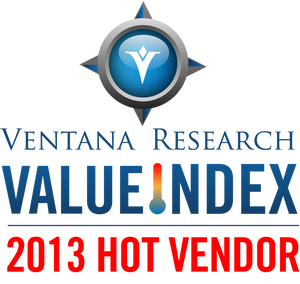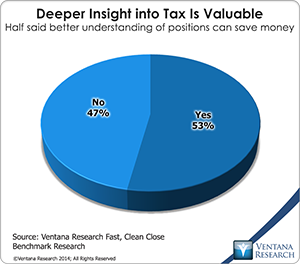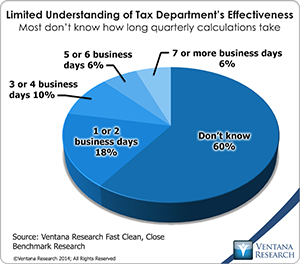Longview Solutions has a longstanding presence in the financial performance management (FPM) software market and was rated a  Hot vendor in our most recent FPM Value Index. Several years ago it began offering a tax provision and planning application. I think it’s worthwhile to focus on the tax category because it’s less well known than others in finance and is an engine of growth for Longview. We expect larger corporations increasingly to adopt software to manage direct (income) taxes to improve the quality and efficiency of what today in most companies is an inefficient, spreadsheet-driven process.
Hot vendor in our most recent FPM Value Index. Several years ago it began offering a tax provision and planning application. I think it’s worthwhile to focus on the tax category because it’s less well known than others in finance and is an engine of growth for Longview. We expect larger corporations increasingly to adopt software to manage direct (income) taxes to improve the quality and efficiency of what today in most companies is an inefficient, spreadsheet-driven process.
Longview’s tax offering consists of four main components. Its Tax Data Platform can be the central repository of a corporation’s tax information. I’ve commented on the need to maintain tax data separate from the data that’s used for financial reporting, managerial accounting and performance management. One reason is that tax accounting must be aligned with legal entities, not corporate organizational structures, because direct taxes are levied on legal entities, not corporate divisions or reporting hierarchies. A second is that tax data must be held in an “as was” state, without regard to subsequent corporate actions such as acquisitions and divestitures or management reorganizations. Longview’s Tax Data Collection software consolidates book and tax data from disparate source systems; it is designed to automate and streamline the movement of data and eliminate time-consuming manual work. It can do consolidations in different, parallel paths if dissimilar methods of consolidating tax-related data are required by the statutes of individual taxing authorities. The Tax Provision/Reporting component performs global tax accounting and reporting. And Tax Planning supports a company’s analysis and planning of its taxes.
Software vendors are taking two different approaches to dedicated tax management software. One mostly focuses on the needs of the finance department: It automates and simplifies incorporation of already calculated tax data into the financial consolidation and close process. This is useful for companies that operate in up to a handful of tax jurisdictions and have relatively simple legal entity structures. The other approach addresses the needs of the tax department as well as the rest of the finance organization. Longview’s tax offering falls into the latter category because it provides the functionality and data-handling capabilities that tax departments need to streamline their operations, enhance their ability to manage tax expenses and improve senior executives’ understanding of tax exposures and strategies to deal with them.
Longview’s tax software can replace desktop spreadsheets, which are the most common tool used for direct tax provisioning and planning in companies of all sizes. Spreadsheets are the wrong choice for managing taxes because they are so time-consuming. Tax  departments use them to make often complex tax calculations, manage tax data and direct tax processes – these are tasks that dedicated software can handle easily but spreadsheets cannot. They are not well equipped to do these tasks quickly and accurately on a consistent basis. Consequently, facing looming deadlines, tax departments have little if any time left over to analyze and plan tax exposure and tax expense options more broadly and more intelligently. Spreadsheets also do not provide sufficient transparency or forward visibility in a timely fashion in the way that a dedicated system can. Spreadsheets make it difficult for companies to manage their tax risk exposure in a consistent fashion across all business units. They do not give executives sufficient insight into their risk exposure options. Our research on the financial close finds that a majority (53%) of finance executives believe that having better understanding of and deeper insight into their company’s tax positions would enable them to reduce their tax expense.
departments use them to make often complex tax calculations, manage tax data and direct tax processes – these are tasks that dedicated software can handle easily but spreadsheets cannot. They are not well equipped to do these tasks quickly and accurately on a consistent basis. Consequently, facing looming deadlines, tax departments have little if any time left over to analyze and plan tax exposure and tax expense options more broadly and more intelligently. Spreadsheets also do not provide sufficient transparency or forward visibility in a timely fashion in the way that a dedicated system can. Spreadsheets make it difficult for companies to manage their tax risk exposure in a consistent fashion across all business units. They do not give executives sufficient insight into their risk exposure options. Our research on the financial close finds that a majority (53%) of finance executives believe that having better understanding of and deeper insight into their company’s tax positions would enable them to reduce their tax expense.
There are several other reasons why desktop spreadsheets are the wrong choice for handling taxes strategically. One is that tax laws and regulations are so fiendishly complex. For example, some countries have industry-specific statutory reporting requirements (for example, for insurance companies and other financial services). Tax calculations for subsidiaries in one country may not apply to those required for a regional headquarters or the parent company. There may be multiple tax rates applicable to a given legal entity and multiple bases or methods on which to apply each tax rate. Moreover, because book accounting for taxes and actual tax calculations almost always differ in multiple ways, it’s necessary to record and track these differences. Since rules, rates and assumptions will vary from year to year, it becomes necessary to adjust these differences. Desktop spreadsheets lack the dimensionality, data integrity and referential integrity necessary to be able to manage this level of detail easily. Dedicated tax management systems are designed to do it.
One reason why tax departments lag in adopting new tools is that until recently the technology necessary for managing the full range of requirements in direct tax analysis, provisioning and compliance was not mature enough for the organizations that needed it the most. Until recently, corporations that operate in multiple, worldwide jurisdictions with even modestly complex legal entity structures overtaxed the ability of IT systems to support them. However, using dedicated software for direct tax management enhances the efficiency of the tax department, enabling it to become more strategic and contribute to improving the company’s results.
Adopting a more strategic approach to managing direct taxes is an emerging trend in finance organizations, but it’s still at an early stage. Tax compliance is usually the main (and overwhelming) focus of tax departments. Most do this essential work reasonably well, but compliance is a tactical issue. To elevate tax management to a strategic level, tax and finance executives must have greater visibility into tax data and how operational decisions affect tax exposures. For example, finance and tax executives may construct a tax-optimized approach to transfer pricing, but their strategy may not be implemented if the company’s incentive compensation system is not aligned to this strategy. Operating managers in high-tax jurisdictions will try to maximize revenues because that’s what they’re rewarded for, even if it results in higher taxes than are necessary. Using spreadsheets is a significant barrier to tax departments taking a more strategic role in their company. When direct taxes are managed using desktop spreadsheets, there rarely is time for organizations to do much more than basic compliance. There’s usually not time to discover the fundamental disconnects between tax strategy and reality or other, similarly strategic activities such as analyzing and assessing the tax implications of long-term corporate plans.
 Indeed, one sign of the tax function’s lack of strategic impact is its invisibility. There is a general lack of understanding of how the tax department functions, even within the finance department. For example, our research discovered that nearly two-thirds of finance executives (and, specifically, 60% of CFOs and controllers) do not know how long it takes their tax department to calculate tax liabilities.
Indeed, one sign of the tax function’s lack of strategic impact is its invisibility. There is a general lack of understanding of how the tax department functions, even within the finance department. For example, our research discovered that nearly two-thirds of finance executives (and, specifically, 60% of CFOs and controllers) do not know how long it takes their tax department to calculate tax liabilities.
Another reason is the relatively low status of tax departments in their company, which we can gauge through the distribution of titles and relatively low compensation for the highly credentialed individuals in these departments. Those that work in tax also tend to be tight-lipped and reluctant to reveal that their processes are time-consuming and difficult to manage, lest they be viewed as less than competent. The tax department’s invisibility contributes to a lack of focus on direct taxation by senior management, which also diminishes an understanding at that level of the potential benefits of investing in technology. Companies that are most likely to want to improve how they manage their direct taxes appear to be the ones where a senior finance department executive has spent time in tax and therefore has a firsthand appreciation for the challenges.
I’ve commented on the need to make tax more strategic. An increasing number of companies are finding that investing in dedicated software to improve the performance of their tax department is worthwhile. It gives them a deeper understanding of how best to manage what is usually one of their biggest expenses and enables them to make more optimal decisions about taxes. I recommend that all larger companies look into the benefits they can achieve by making their tax department more strategic and that they investigate dedicated software such as Longview’s that can enable them to have such a strategic tax function.
Regards,
Robert Kugel – SVP Research


 Hot vendor in our most recent
Hot vendor in our most recent 










